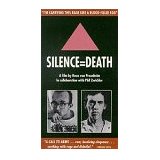Plot
The film centers on the responses of gay artists in New York City to the AIDS crisis. Filmmaker Phil Zwickler conducts interviews of various individuals, such as graffiti artist Keith Haring; painter Rafael Gamba, who calls out homophobic bigotry; poet Allen Ginsberg, who offers his opinion on sexual attitudes; David Wojnarowicz, Paul Smith, Peter Kunz, Ed Koch, Don Moffett, Bern Boyle, and Emilio Cubeiro.
Reception
Film critic Janet Maslin observed that at the beginning of the film "a man tells the camera he has tested HIV positive for the AIDS virus; he talks briefly and angrily about his feelings, then suddenly lowers his pants and seems to shoot himself anally with a pistol at very close camera range." She goes on to note that this is only a simulated act of suicide, although "it is deadly all the same, insofar as it defines and limits von Praunheim's approach to reaching his audience." [2]
Kevin Thomas wrote in the Los Angeles Times that the film makes a compelling case for all closeted gays "to come out and join the struggle to press for a cure for the disease and for more education in regard to its prevention, especially at a time when gay bashing is on the rise and when the far-right and various religious groups seem determined to view AIDS as a fit punishment for homosexuals." [3]
Stuart Galbraith wrote in The Ann Arbor News that while there are several recognizable LGBTQ artists in the film, "much of the film's characters are made up of fringe-types, whose artwork is all well and good, but who tend to detract away from the subject of the film rather than complement it." [4] In his review for the Los Angeles Daily News , Bob Strauss wrote that if you can get past the simulated suicide at the start of the film, then "nothing that comes after it should throw you, still, it sets the tone for a movie that has no intention of being polite." [5]
Film critic Craig Seligman stated that the artists featured in the film "have a lot of anger to express, and wanting to sneak away from it may not make you a raving reactionary; it may have something to do with the failures of their art, or with the director's botched attempts to capture it." [6]
This page is based on this
Wikipedia article Text is available under the
CC BY-SA 4.0 license; additional terms may apply.
Images, videos and audio are available under their respective licenses.
